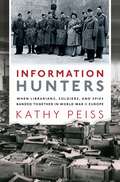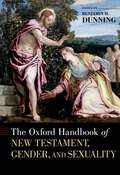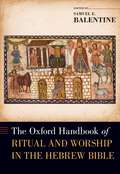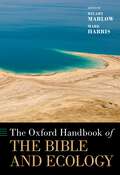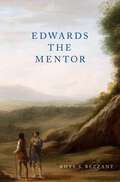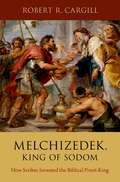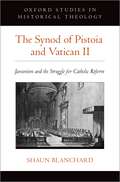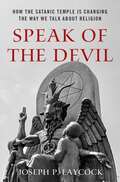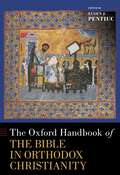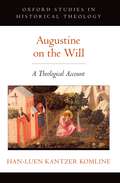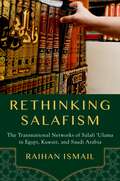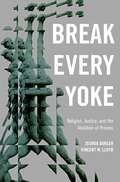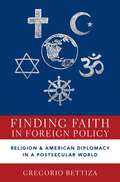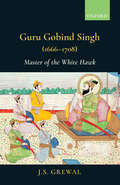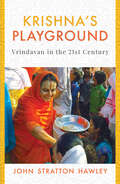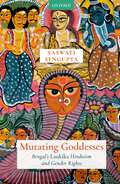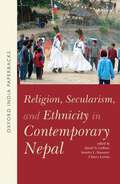- Table View
- List View
Information Hunters: When Librarians, Soldiers, and Spies Banded Together in World War II Europe
by Kathy PeissWhile armies have seized enemy records and rare texts as booty throughout history, it was only during World War II that an unlikely band of librarians, archivists, and scholars traveled abroad to collect books and documents to aid the military cause. Galvanized by the events of war into acquiring and preserving the written word, as well as providing critical information for intelligence purposes, these American civilians set off on missions to gather foreign publications and information across Europe. They journeyed to neutral cities in search of enemy texts, followed a step behind advancing armies to capture records, and seized Nazi works from bookstores and schools. When the war ended, they found looted collections hidden in cellars and caves. Their mission was to document, exploit, preserve, and restitute these works, and even, in the case of Nazi literature, to destroy them. In this fascinating account, cultural historian Kathy Peiss reveals how book and document collecting became part of the new apparatus of intelligence and national security, military planning, and postwar reconstruction. Focusing on the ordinary Americans who carried out these missions, she shows how they made decisions on the ground to acquire sources that would be useful in the war zone as well as on the home front. These collecting missions also boosted the postwar ambitions of American research libraries, offering a chance for them to become great international repositories of scientific reports, literature, and historical sources. Not only did their wartime work have lasting implications for academic institutions, foreign-policy making, and national security, it also led to the development of today's essential information science tools. Illuminating the growing global power of the United States in the realms of intelligence and cultural heritage, Peiss tells the story of the men and women who went to Europe to collect and protect books and information and in doing so enriches the debates over the use of data in times of both war and peace.
The Oxford Handbook of New Testament, Gender, and Sexuality (Oxford Handbooks)
by Benjamin H. DunningOver several decades, scholarship in New Testament and early Christianity has drawn attention both to the ways in which ancient Mediterranean conceptions of embodiment, sexual difference, and desire were fundamentally different from modern ones and also to important lines of genealogical connection between the past and the present. The result is that the study of "gender" and "sexuality" in early Christianity has become an increasingly complex undertaking. This is a complexity produced not only by the intricacies of conflicting historical data, but also by historicizing approaches that query the very terms of analysis whereby we inquire into these questions in the first place. Yet at the same time, recent work on these topics has produced a rich and nuanced body of scholarly literature that has contributed substantially to our understanding of early Christian history and also proved relevant to ongoing theological and social debates. The Oxford Handbook of Gender and Sexuality in the New Testament provides a roadmap to this lively scholarly landscape, introducing both students and other scholars to the relevant problems, debates, and issues. Leading scholars in the field offer original contributions by way of synthesis, critical interrogation, and proposals for future questions, hypotheses, and research trajectories.
The Oxford Handbook of Ritual and Worship in the Hebrew Bible (Oxford Handbooks)
by Samuel E. BalentineRitual has a primal connection to the idea that a transcendent order - numinous and mysterious, supranatural and elusive, divine and wholly other - gives meaning and purpose to life. The construction of rites and rituals enables humans to conceive and apprehend this transcendent order, to symbolize it and interact with it, to postulate its truths in the face of contradicting realities and to repair them when they have been breached or diminished. This Handbook provides a compendium of the information essential for constructing a comprehensive and integrated account of ritual and worship in the ancient world. Its focus on ritual and worship from the perspective of biblical studies, as opposed to religious studies, highlights that the world of ritual and worship was a topic of central concern for the people of the Ancient Near East, including the world of the Bible. Given the scarcity of the material in the Bible itself, the authors in this collection use materials from the ancient Near East to provide a larger context for the practices of the biblical world, giving due attention to historical, anthropological, and social scientific methods that inform the context of biblical worship. The specifics of ritual and worship life-the sacred spaces, times, and actors in worship-are examined in detail, with essays covering both the divine and human aspects of the sacred dimension. The Oxford Handbook of Ritual and Worship in the Hebrew Bible considers several underlying concepts of ritual practice and closes with a theological outlook on worship and ritual from a variety of perspectives, demonstrating a fruitful exchange between biblical studies, ritual theory, and social science research.
The Oxford Handbook of the Bible and Ecology (Oxford Handbooks)
by Hilary Marlow and Mark HarrisEnvironmental issues are an ever-increasing focus of public discourse and have proved concerning to religious groups as well as society more widely. Among biblical scholars, criticism of the Judeo-Christian tradition for its part in the worsening crisis has led to a small but growing field of study on ecology and the Bible. This volume in the Oxford Handbook series makes a significant contribution to this burgeoning interest in ecological hermeneutics, incorporating the best of international scholarship on ecology and the Bible. The Handbook comprises 30 individual essays on a wide range of relevant topics by established and emerging scholars. Arranged in four sections, the volume begins with a historical overview before tackling some key methodological issues. The second, substantial, section comprises thirteen essays offering detailed exegesis from an ecological perspective of selected biblical books. This is followed by a section exploring broader thematic topics such as the Imago Dei and stewardship. Finally, the volume concludes with a number of essays on contemporary perspectives and applications, including political and ethical considerations. The editors Hilary Marlow and Mark Harris have drawn on their experience in Hebrew Bible and New Testament respectively to bring together a diverse and engaging collection of essays on a subject of immense relevance. Its accessible style, comprehensive scope, and range of material means that the volume is a valuable resource, not only to students and scholars of the Bible but also to religious leaders and practitioners.
EDWARDS THE MENTOR C
by Rhys S. BezzantAmong his many accomplishments, Jonathan Edwards was an effective mentor who trained many leaders for the church in colonial America, but his pastoral work is often overlooked. Rhys S. Bezzant investigates the background, method, theological rationale, and legacy of his mentoring ministry. Edwards did what mentors normally do--he met with individuals to discuss ideas and grow in skills. But Bezzant shows that Edwards undertook these activities in a distinctly modern or affective key. His correspondence is written in an informal style; his understanding of friendship and conversation takes up the conventions of the great metropolitan cities of Europe. His pedagogical commitments are surprisingly progressive and his aspirations for those he mentored are bold and subversive. When he explains his mentoring practice theologically, he expounds the theme of seeing God face to face, summarized in the concept of the beatific vision, which recognizes that human beings learn through the example of friends as well as through the exposition of propositions. In this book the practice of mentoring is presented as an exchange between authority and agency, in which the more experienced person empowers the other, whose own character and competencies are thus nurtured. More broadly, the book is a case study in cultural engagement, for Edwards deliberately takes up certain features of the modern world in his mentoring and yet resists other pressures that the Enlightenment generated. If his world witnessed the philosophical evacuation of God from the created order, then Edwards's mentoring is designed to draw God back into an intimate connection with human experience.
Melchizedek, King of Sodom: How Scribes Invented the Biblical Priest-King
by Robert R. CargillThe biblical figure Melchizedek appears just twice in the Hebrew Bible, and once more in the Christian New Testament. Cited as both the king of Shalem-understood by most scholars to be Jerusalem-and as an eternal priest without ancestry, Melchizedek's appearances become textual justification for tithing to the Levitical priests in Jerusalem and for the priesthood of Jesus Christ himself. But what if the text was manipulated? Robert R. Cargill explores the Hebrew and Greek texts concerning Melchizedek's encounter with Abraham in Genesis as a basis to unravel the biblical mystery of this character's origins. The textual evidence that Cargill presents shows that Melchizedek was originally known as the king of Sodom and that the later traditions about Sodom forced biblical scribes to invent a new location, Shalem, for Melchizedek's priesthood and reign. Cargill also identifies minor, strategic changes to the Hebrew Bible and the Samaritan Pentateuch that demonstrate an evolving, polemical, sectarian discourse between Jews and Samaritans competing for the superiority of their respective temples and holy mountains. The resulting literary evidence was used as the ideological motivation for identifying Shalem with Jerusalem in the Second Temple Jewish tradition. A brief study with far-reaching implications, Melchizedek, King of Sodom reopens discussion of not only this unusual character, but also the origins of both the priesthood of Christ and the role of early Israelite priest-kings.
Melchizedek, King of Sodom: How Scribes Invented the Biblical Priest-King
by Robert R. CargillThe biblical figure Melchizedek appears just twice in the Hebrew Bible, and once more in the Christian New Testament. Cited as both the king of Shalem-understood by most scholars to be Jerusalem-and as an eternal priest without ancestry, Melchizedek's appearances become textual justification for tithing to the Levitical priests in Jerusalem and for the priesthood of Jesus Christ himself. But what if the text was manipulated? Robert R. Cargill explores the Hebrew and Greek texts concerning Melchizedek's encounter with Abraham in Genesis as a basis to unravel the biblical mystery of this character's origins. The textual evidence that Cargill presents shows that Melchizedek was originally known as the king of Sodom and that the later traditions about Sodom forced biblical scribes to invent a new location, Shalem, for Melchizedek's priesthood and reign. Cargill also identifies minor, strategic changes to the Hebrew Bible and the Samaritan Pentateuch that demonstrate an evolving, polemical, sectarian discourse between Jews and Samaritans competing for the superiority of their respective temples and holy mountains. The resulting literary evidence was used as the ideological motivation for identifying Shalem with Jerusalem in the Second Temple Jewish tradition. A brief study with far-reaching implications, Melchizedek, King of Sodom reopens discussion of not only this unusual character, but also the origins of both the priesthood of Christ and the role of early Israelite priest-kings.
The Synod of Pistoia and Vatican II: Jansenism and the Struggle for Catholic Reform (Oxford Studies in Historical Theology)
by Shaun BlanchardIn this book, Shaun Blanchard argues that the roots of the Vatican II reforms must be pushed back beyond the widely acknowledged twentieth-century forerunners of the Council, beyond Newman and the Tübingen School in the nineteenth century, to the eighteenth century, when a variety of reform movements attempted ressourcement and aggiornamento. This close study of the Synod of Pistoia (1786) sheds surprising new light on the nature of church reform and the roots of the Second Vatican Council (1962-65). The high-water mark of the late Jansenist reform movement, this Tuscan diocesan synod was harshly condemned by Pope Pius VI in the Bull Auctorem fidei (1794), and in the increasingly ultramontane nineteenth-century Church the late Jansenist movement was totally discredited. Nevertheless, much of the Pistoian agenda--an exaltation of the role of the local bishop, an emphasis on infallibility as a gift to the entire believing community, religious liberty, a more comprehensible liturgy that incorporates the vernacular, and the encouragement of lay Bible reading and Christocentric devotions--would be officially promulgated at Vatican II. Investigating the theological and historical context and nature of the reforms enacted by the Synod of Pistoia, he notes their parallels with the reforms of Vatican II, and argues that these connections are deeper than mere affinity. The tumultuous events surrounding the reception of the Synod explain why these reforms failed at the time. This book also offers a measured theological judgment on whether the Synod of Pistoia was "true or false reform." Although the Pistoians were completely rejected in their own day, the Second Vatican Council struggled with, and ultimately enacted, remarkably similar ideas.
The Synod of Pistoia and Vatican II: Jansenism and the Struggle for Catholic Reform (Oxford Studies in Historical Theology)
by Shaun BlanchardIn this book, Shaun Blanchard argues that the roots of the Vatican II reforms must be pushed back beyond the widely acknowledged twentieth-century forerunners of the Council, beyond Newman and the Tübingen School in the nineteenth century, to the eighteenth century, when a variety of reform movements attempted ressourcement and aggiornamento. This close study of the Synod of Pistoia (1786) sheds surprising new light on the nature of church reform and the roots of the Second Vatican Council (1962-65). The high-water mark of the late Jansenist reform movement, this Tuscan diocesan synod was harshly condemned by Pope Pius VI in the Bull Auctorem fidei (1794), and in the increasingly ultramontane nineteenth-century Church the late Jansenist movement was totally discredited. Nevertheless, much of the Pistoian agenda--an exaltation of the role of the local bishop, an emphasis on infallibility as a gift to the entire believing community, religious liberty, a more comprehensible liturgy that incorporates the vernacular, and the encouragement of lay Bible reading and Christocentric devotions--would be officially promulgated at Vatican II. Investigating the theological and historical context and nature of the reforms enacted by the Synod of Pistoia, he notes their parallels with the reforms of Vatican II, and argues that these connections are deeper than mere affinity. The tumultuous events surrounding the reception of the Synod explain why these reforms failed at the time. This book also offers a measured theological judgment on whether the Synod of Pistoia was "true or false reform." Although the Pistoians were completely rejected in their own day, the Second Vatican Council struggled with, and ultimately enacted, remarkably similar ideas.
Speak of the Devil: How The Satanic Temple is Changing the Way We Talk about Religion
by Joseph P. LaycockIn 2013, when the state of Oklahoma erected a statue of the Ten Commandments on the grounds of the state capitol, a group calling themselves The Satanic Temple applied to erect a statue of Baphomet alongside the Judeo-Christian tablets. Since that time, The Satanic Temple has become a regular voice in national conversations about religious freedom, disestablishment, and government overreach. In addition to petitioning for Baphomet to appear alongside another monument of the Ten Commandments in Arkansas, the group has launched campaigns to include Satanic "nativity scenes" on government property in Florida, Michigan, and Indiana, offer Satanic prayers at a high school football game in Seattle, and create "After School Satan" programs in elementary schools that host Christian extracurricular programs. Since their 2012 founding, The Satanic Temple has established 19 chapters and now claims 100,000 supporters. Is this just a political group perpetuating a series of stunts? Or is it a sincere religious movement? Speak of the Devil is the first book-length study of The Satanic Temple. Joseph Laycock, a scholar of new religious movements, contends that the emergence of "political Satanism" marks a significant moment in American religious history that will have a lasting impact on how Americans frame debates about religious freedom. Though the group gained attention for its strategic deployment of outrage, it claims to have developed beyond politics into a genuine religious movement. Equal parts history and ethnography, Speak of the Devil is Laycock's attempt to take seriously The Satanic Temple's work to redefine religion, the nature of pluralism and religious tolerance, and what "religious freedom" means in America.
Speak of the Devil: How The Satanic Temple is Changing the Way We Talk about Religion
by Joseph P. LaycockIn 2013, when the state of Oklahoma erected a statue of the Ten Commandments on the grounds of the state capitol, a group calling themselves The Satanic Temple applied to erect a statue of Baphomet alongside the Judeo-Christian tablets. Since that time, The Satanic Temple has become a regular voice in national conversations about religious freedom, disestablishment, and government overreach. In addition to petitioning for Baphomet to appear alongside another monument of the Ten Commandments in Arkansas, the group has launched campaigns to include Satanic "nativity scenes" on government property in Florida, Michigan, and Indiana, offer Satanic prayers at a high school football game in Seattle, and create "After School Satan" programs in elementary schools that host Christian extracurricular programs. Since their 2012 founding, The Satanic Temple has established 19 chapters and now claims 100,000 supporters. Is this just a political group perpetuating a series of stunts? Or is it a sincere religious movement? Speak of the Devil is the first book-length study of The Satanic Temple. Joseph Laycock, a scholar of new religious movements, contends that the emergence of "political Satanism" marks a significant moment in American religious history that will have a lasting impact on how Americans frame debates about religious freedom. Though the group gained attention for its strategic deployment of outrage, it claims to have developed beyond politics into a genuine religious movement. Equal parts history and ethnography, Speak of the Devil is Laycock's attempt to take seriously The Satanic Temple's work to redefine religion, the nature of pluralism and religious tolerance, and what "religious freedom" means in America.
The Oxford Handbook of the Bible in Orthodox Christianity (OXFORD HANDBOOKS SERIES)
The Oxford Handbook of the Bible in Orthodox Christianity investigates the various ways in which Orthodox Christian, i.e., Eastern and Oriental, communities, have received, shaped, and interpreted the Christian Bible. The handbook is divided into five parts: Text, Canon, Scripture within Tradition, Toward an Orthodox Hermeneutics, and Looking to the Future. The first part focuses on how the Orthodox Church has never codified the Septuagint or any other textual witnesses as its authoritative text. Textual fluidity and pluriformity, a characteristic of Orthodoxy, is demonstrated by the various ancient and modern Bible translations into Syriac, Coptic, Ethiopian, Armenian among other languages. The second part discusses how, unlike in the Protestant and Roman-Catholic faiths where the canon of the Bible is "closed" and limited to 39 and 46 books, respectively, the Orthodox canon is "open-ended," consisting of 39 canonical books and 10 or more anaginoskomena or "readable" books as additions to Septuagint. The third part shows how, unlike the classical Protestant view of sola scriptura and the Roman Catholic way of placing Scripture and Tradition on par as sources or means of divine revelation, the Orthodox view accords a central role to Scripture within Tradition, with the latter conceived not as a deposit of faith but rather as the Church's life through history. The final two parts survey "traditional" Orthodox hermeneutics consisting mainly of patristic commentaries and liturgical interpretations found in hymnography and iconography, and the ways by which Orthodox biblical scholars balance these traditional hermeneutics with modern historical-critical approaches to the Bible.
The Oxford Handbook of the Bible in Orthodox Christianity (OXFORD HANDBOOKS SERIES)
by Eugen J. PentiucThe Oxford Handbook of the Bible in Orthodox Christianity investigates the various ways in which Orthodox Christian, i.e., Eastern and Oriental, communities, have received, shaped, and interpreted the Christian Bible. The handbook is divided into five parts: Text, Canon, Scripture within Tradition, Toward an Orthodox Hermeneutics, and Looking to the Future. The first part focuses on how the Orthodox Church has never codified the Septuagint or any other textual witnesses as its authoritative text. Textual fluidity and pluriformity, a characteristic of Orthodoxy, is demonstrated by the various ancient and modern Bible translations into Syriac, Coptic, Ethiopian, Armenian among other languages. The second part discusses how, unlike in the Protestant and Roman-Catholic faiths where the canon of the Bible is "closed" and limited to 39 and 46 books, respectively, the Orthodox canon is "open-ended," consisting of 39 canonical books and 10 or more anaginoskomena or "readable" books as additions to Septuagint. The third part shows how, unlike the classical Protestant view of sola scriptura and the Roman Catholic way of placing Scripture and Tradition on par as sources or means of divine revelation, the Orthodox view accords a central role to Scripture within Tradition, with the latter conceived not as a deposit of faith but rather as the Church's life through history. The final two parts survey "traditional" Orthodox hermeneutics consisting mainly of patristic commentaries and liturgical interpretations found in hymnography and iconography, and the ways by which Orthodox biblical scholars balance these traditional hermeneutics with modern historical-critical approaches to the Bible.
Augustine on the Will: A Theological Account (Oxford Studies in Historical Theology)
by Han-luen Kantzer KomlineThis book provides a framework for Augustine's understanding of will, an aspect of his thought that has proven to be both essential and inscrutable. On the one hand, the Augustinian will is everywhere. It comes up constantly both in Augustine's thought and in the massive literature engaging it. The will is impossible to avoid in almost any treatment of any aspect of his thinking, whether theological, philosophical, psychological, or political, because it is at the heart of his understanding of the human person and therefore vital to his understanding of such diverse topics as grace, freedom, the image of God, and moral responsibility. On the other hand, Augustine's understanding of the will resists direct examination. With the exception of an early treatise on free choice, Augustine never devoted a work to exploring the will in a programmatic way. Likewise, while the Augustinian will is constantly invoked in secondary literature, it rarely receives analysis in its own right. Han-luen Kantzer Komline demonstrates that Augustine's view is "theologically differentiated," comprising four distinct types of human will, which correspond to four different theological scenarios. Augustine's innovation consists in distinguishing these types with a detail and clarity unprecedented by any thinker before him. This account of the Augustinian will gives a comprehensive picture of the development and mature shape of Augustine's thinking on this vital yet perennially puzzling topic.
Augustine on the Will: A Theological Account (Oxford Studies in Historical Theology)
by Han-luen Kantzer KomlineThis book provides a framework for Augustine's understanding of will, an aspect of his thought that has proven to be both essential and inscrutable. On the one hand, the Augustinian will is everywhere. It comes up constantly both in Augustine's thought and in the massive literature engaging it. The will is impossible to avoid in almost any treatment of any aspect of his thinking, whether theological, philosophical, psychological, or political, because it is at the heart of his understanding of the human person and therefore vital to his understanding of such diverse topics as grace, freedom, the image of God, and moral responsibility. On the other hand, Augustine's understanding of the will resists direct examination. With the exception of an early treatise on free choice, Augustine never devoted a work to exploring the will in a programmatic way. Likewise, while the Augustinian will is constantly invoked in secondary literature, it rarely receives analysis in its own right. Han-luen Kantzer Komline demonstrates that Augustine's view is "theologically differentiated," comprising four distinct types of human will, which correspond to four different theological scenarios. Augustine's innovation consists in distinguishing these types with a detail and clarity unprecedented by any thinker before him. This account of the Augustinian will gives a comprehensive picture of the development and mature shape of Augustine's thinking on this vital yet perennially puzzling topic.
Rethinking Salafism: The Transnational Networks of Salafi 'Ulama in Egypt, Kuwait, and Saudi Arabia
by Raihan IsmailSalafism has received scrutiny as the one of the main ideological sources for extremist violence perpetrated by jihadi groups. There is a significant corpus of literature discussing transnational jihadi networks, especially after the 9/11 attacks in the United States. These discussions include the radicalization of Salafi thought by jihadi theoreticians and 'ulama. However, Salafism is not monolithic. It contains numerous streams, and an examination of these streams is crucial to understanding its influence on Muslim societies. Besides Salafi jihadisthose who sanction violencethere are two other broad trends in Salafism: quietist and activist. Quietist Salafis endorse an apolitical tradition and find political activism in any form unacceptable. Activist Salafis advocate peaceful political change. Each stream is led by 'ulama, seen as the preservers of Salafi traditions. The quietist and activist 'ulama are active participants in their communities. Studies of such clerics have tended to be country-specific, focusing on the influence and nature of Salafism and its dynamics in those countries. In Rethinking Salafism Raihan Ismail assesses the origins, interactions, and dynamics of the transnational networks of Salafi 'ulama in the region comprising Saudi Arabia, Egypt, and Kuwait, showing how quietist and activist 'ulama work across borders to preserve and promote what they see as "authentic" Salafism while taking domestic circumstances of the 'ulama into consideration. The book offers a reassessment of the quietist/activist dichotomy, arguing that this dichotomy does not apply to such aspects of Salafi thought as attitudes towards the Shi'a and social matters in Muslim societies.
Rethinking Salafism: The Transnational Networks of Salafi 'Ulama in Egypt, Kuwait, and Saudi Arabia
by Raihan IsmailSalafism has received scrutiny as the one of the main ideological sources for extremist violence perpetrated by jihadi groups. There is a significant corpus of literature discussing transnational jihadi networks, especially after the 9/11 attacks in the United States. These discussions include the radicalization of Salafi thought by jihadi theoreticians and 'ulama. However, Salafism is not monolithic. It contains numerous streams, and an examination of these streams is crucial to understanding its influence on Muslim societies. Besides Salafi jihadisthose who sanction violencethere are two other broad trends in Salafism: quietist and activist. Quietist Salafis endorse an apolitical tradition and find political activism in any form unacceptable. Activist Salafis advocate peaceful political change. Each stream is led by 'ulama, seen as the preservers of Salafi traditions. The quietist and activist 'ulama are active participants in their communities. Studies of such clerics have tended to be country-specific, focusing on the influence and nature of Salafism and its dynamics in those countries. In Rethinking Salafism Raihan Ismail assesses the origins, interactions, and dynamics of the transnational networks of Salafi 'ulama in the region comprising Saudi Arabia, Egypt, and Kuwait, showing how quietist and activist 'ulama work across borders to preserve and promote what they see as "authentic" Salafism while taking domestic circumstances of the 'ulama into consideration. The book offers a reassessment of the quietist/activist dichotomy, arguing that this dichotomy does not apply to such aspects of Salafi thought as attitudes towards the Shi'a and social matters in Muslim societies.
Break Every Yoke: Religion, Justice, and the Abolition of Prisons
by Joshua Dubler Vincent LloydChanges in the American religious landscape enabled the rise of mass incarceration. Religious ideas and practices also offer a key for ending mass incarceration. These are the bold claims advanced by Break Every Yoke, the joint work of two activist-scholars of American religion. Once, in an era not too long past, Americans, both incarcerated and free, spoke a language of social liberation animated by religion. In the era of mass incarceration, we have largely forgotten how to dream-and organize-this way. To end mass incarceration we must reclaim this lost tradition. Properly conceived, the movement we need must demand not prison reform but prison abolition. Break Every Yoke weaves religion into the stories about race, politics, and economics that conventionally account for America's grotesque prison expansion of the last half century, and in so doing it sheds new light on one of our era's biggest human catastrophes. By foregrounding the role of religion in the way political elites, religious institutions, and incarcerated activists talk about incarceration, Break Every Yoke is an effort to stretch the American moral imagination and contribute resources toward envisioning alternative ways of doing justice. By looking back to nineteenth century abolitionism, and by turning to today's grassroots activists, it argues for reclaiming the abolition "spirit."
Break Every Yoke: Religion, Justice, and the Abolition of Prisons
by Joshua Dubler Vincent LloydChanges in the American religious landscape enabled the rise of mass incarceration. Religious ideas and practices also offer a key for ending mass incarceration. These are the bold claims advanced by Break Every Yoke, the joint work of two activist-scholars of American religion. Once, in an era not too long past, Americans, both incarcerated and free, spoke a language of social liberation animated by religion. In the era of mass incarceration, we have largely forgotten how to dream-and organize-this way. To end mass incarceration we must reclaim this lost tradition. Properly conceived, the movement we need must demand not prison reform but prison abolition. Break Every Yoke weaves religion into the stories about race, politics, and economics that conventionally account for America's grotesque prison expansion of the last half century, and in so doing it sheds new light on one of our era's biggest human catastrophes. By foregrounding the role of religion in the way political elites, religious institutions, and incarcerated activists talk about incarceration, Break Every Yoke is an effort to stretch the American moral imagination and contribute resources toward envisioning alternative ways of doing justice. By looking back to nineteenth century abolitionism, and by turning to today's grassroots activists, it argues for reclaiming the abolition "spirit."
Finding Faith in Foreign Policy: Religion and American Diplomacy in a Postsecular World
by Gregorio BettizaSince the end of the Cold War, religion has become an ever more explicit and systematic focus of US foreign policy across multiple domains. US foreign policymakers, for instance, have been increasingly tasked with monitoring religious freedom and promoting it globally, delivering humanitarian and development aid abroad by drawing on faith-based organizations, fighting global terrorism by seeking to reform Muslim societies and Islamic theologies, and advancing American interests and values more broadly worldwide by engaging with religious actors and dynamics. Simply put, religion has become a major subject and object of American foreign policy in ways that were unimaginable just a few decades ago. In Finding Faith in Foreign Policy, Gregorio Bettiza explains the causes and consequences of this shift by developing an original theoretical framework and drawing upon extensive empirical research and interviews. He argues that American foreign policy and religious forces have become ever more inextricably entangled in an age witnessing a global resurgence of religion and the emergence of a postsecular world society. He further shows how the boundaries between faith and state have been redefined through processes of desecularization in the context of American foreign policy, leading the most powerful state in the international system to intervene and reshape in increasingly sustained ways sacred and secular landscapes around the globe. Drawing from a rich evidentiary base spanning twenty-five years, Finding Faith in Foreign Policy details how a wave of religious enthusiasm has transformed not just American foreign policy, but the entire international system.
Finding Faith in Foreign Policy: Religion and American Diplomacy in a Postsecular World
by Gregorio BettizaSince the end of the Cold War, religion has become an ever more explicit and systematic focus of US foreign policy across multiple domains. US foreign policymakers, for instance, have been increasingly tasked with monitoring religious freedom and promoting it globally, delivering humanitarian and development aid abroad by drawing on faith-based organizations, fighting global terrorism by seeking to reform Muslim societies and Islamic theologies, and advancing American interests and values more broadly worldwide by engaging with religious actors and dynamics. Simply put, religion has become a major subject and object of American foreign policy in ways that were unimaginable just a few decades ago. In Finding Faith in Foreign Policy, Gregorio Bettiza explains the causes and consequences of this shift by developing an original theoretical framework and drawing upon extensive empirical research and interviews. He argues that American foreign policy and religious forces have become ever more inextricably entangled in an age witnessing a global resurgence of religion and the emergence of a postsecular world society. He further shows how the boundaries between faith and state have been redefined through processes of desecularization in the context of American foreign policy, leading the most powerful state in the international system to intervene and reshape in increasingly sustained ways sacred and secular landscapes around the globe. Drawing from a rich evidentiary base spanning twenty-five years, Finding Faith in Foreign Policy details how a wave of religious enthusiasm has transformed not just American foreign policy, but the entire international system.
Guru Gobind Singh (1666–1708): Master of the White Hawk
by J. S. GrewalThe unifying theme in the life of Guru Gobind Singh was confrontation with the Mughals, which culminated in a struggle for political power. This fact is brought into sharp focus when we consider the Guru’s life and legacy simultaneously in the contexts of the Mughal Empire, its feudatory states in the hills, and the Sikh movement. The creation of the Khalsa in 1699 as a political community with the aspiration to rule made conciliation or compromise with the Mughal state almost impossible. Their long struggle ended eventually in the declaration of Khalsa Raj in 1765. Using contemporary and near contemporary sources in Gurmukhi, Persian, and English, J.S. Grewal presents a comprehensive study of this era of Sikh history. The volume elaborates on the life and legacy of Guru Gobind Singh and explores the ideological background of the institution of the Khalsa and its larger political context. Grewal, however, emphasizes that the legacy of the Khalsa was also social and cultural. This authoritative volume on the tenth Guru is a significant addition to the field of Sikh studies.
Krishna’s Playground: Vrindavan in the 21st Century
by John Stratton HawleyThis is a book about a deeply beloved place—many call it the spiritual capital of India. Located at a dramatic bend in the River Yamuna, a hundred miles from the center of Delhi, Vrindavan is the spot where the god Krishna is believed to have spent his childhood and youth. For Hindus it has always stood for youth writ large—a realm of love and beauty that enables one to retreat from the weight and harshness of the world. Now, though, the world is gobbling up Vrindavan. Delhi’s megalopolitan sprawl inches closer day by day—half the town is a vast real-estate development—and the waters of the Yamuna are too polluted to drink or even bathe in. Temples now style themselves as theme parks, and the world’s tallest religious building is under construction in Krishna’s pastoral paradise. What happens when the Anthropocene Age makes everything virtual? What happens when heaven gets plowed under? Like our age as a whole, Vrindavan throbs with feisty energy, but is it the religious canary in our collective coal mine?
Mutating Goddesses: Bengal’s Laukika Hinduism and Gender Rights
by Saswati SenguptaMutating Goddesses traces the shifting fortunes of four specific Hindu deities—Manasa, Candi, Sasthi and Laksmi—from the fifteenth century to the present time. It focuses on the goddess-invested tradition of Bengal's Hinduism to argue for a historical evolution/devolution of divinities in tandem with sectarian interests and illumines in the process the knotted correlation of gender, caste and class in the sanctioning of female subjectivities through goddess formation. The critical studies of Hindu goddesses have been dominated by the sastrik perspective deriving from the Sanskrit scriptures authorized by the male Brahman. But there are religious practices and beliefs under the broad rubric of Hinduism that are neither governed by the male Brahman nor articulated in Sanskrit. It is this vibrant laukika archive—considered low from the hegemonic perspective—that Mutating Goddesses explores to realize the politic trafficking between this realm and the sastrik. The book excavates the multiple and layered heritage of the region which includes tribal culture, Buddhism, Tantricism, and so on, as is available in rituals, proverbs, verses, circulating myths, poetic genres and kathas, caste manuals, census records etc to illustrate how tradition is a matter of strategic selection.
Religion, Secularism, and Ethnicity in Contemporary Nepal
by David N. Gellner Sondra L. Hausner Chiara LetiziaThe socio-political landscape of Nepal has been rocked by dramatic and far-reaching changes in the past thirty years. Following a ten-year Maoist revolution and civil war, the country has transitioned from a monarchy to a republic. The former Hindu kingdom has declared its commitment to secularism, without coming to any agreement on what secularism means or should mean in the Nepalese context. What happens to religion under conditions of such rapid social and political change? How do the changes in public festivals reflect and/or create new group identities? Is the gap between the urban and the rural narrowing? How is the state dealing with Nepal’s multicultural and multi-religious society? How are Nepalis understanding, resisting, and adapting ideas of secularism? In order to answer these important questions, this volume brings together eleven case studies by an international team of anthropologists and ethno-Indologists of Nepal on such diverse topics as secularism, individualism, shamanism, animal sacrifice, the role of state functionaries in festivals, clashes and synergies between Maoism and Buddhism, and conversion to Christianity. In an Afterword, renowned political theorist Rajeev Bhargava presents a comparative analysis of Nepal’s experiences and asks whether the country is finding its own solution to the conundrum of secularism.
